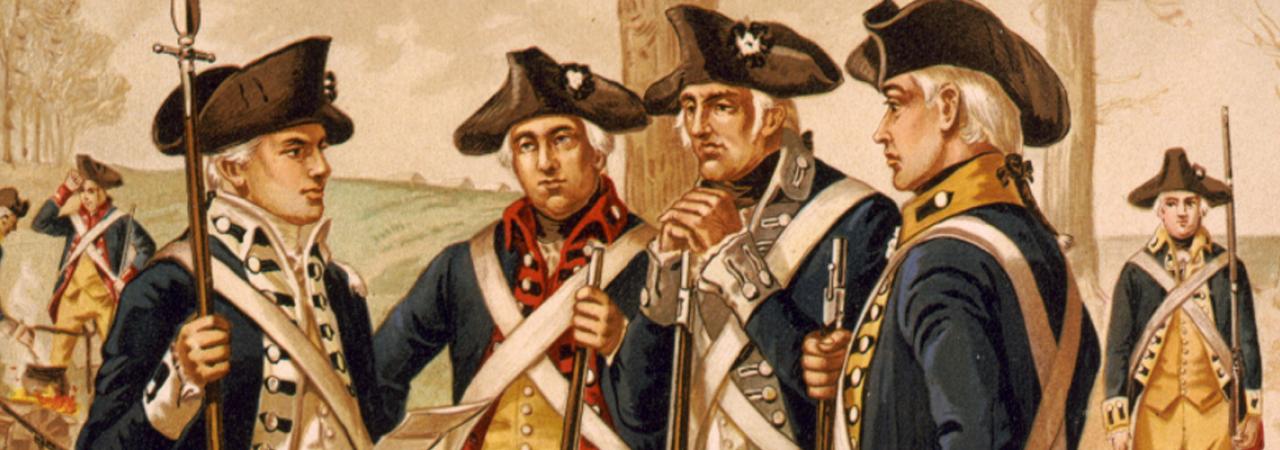
“Revolutionary War Pension Records Restored, Consolidated, and Explained. Part One” By Lloyd DeWitt Bockstruck
Editor’s Note:
Lloyd DeWitt Bockstruck’s groundbreaking book, Revolutionary War Pensions Awarded by State Governments 1775-1874, the General and Federal Governments Prior to 1814, and by Private Acts of Congress to 1905, identifies and recreates the Revolutionary War pension files generated prior to the disastrous fire in the War Department on 8 November 1800, and a second and even more disastrous fire on 24 August 1814 with the British invasion of Washington. Mr. Bockstruck has not only identified many of those pensioners whose files are commonly believed to have been lost but also reconstructed in varying degrees their contents. More than 16,500 pensioners are featured in this work. The Introduction to Mr. Bockstruck’s book is a bibliographical essay that both explains the legislative and archival history of the Revolutionary War pensions and identifies the existing sources–primarily the pension records of the Original Thirteen States and various Congressional sources—that the author utilized in this massive attempt at evidentiary reconstruction. This article, published in two parts, is excerpted from that Introduction.
Revolutionary War Pensions Awarded by State Governments 1775-1874, the General and Federal Governments Prior to 1814, and by Private Acts of Congress to 1905 is an attempt to identify and recreate the Revolutionary War pension files generated prior to the disastrous fires of 8 November 1800, and 24 August 1814, during the British invasion of Washington, D.C. The second fire effectively eliminated all of the pension files from 1776 to 1814. Despite these record losses, it has been possible not only to identify many of those pensioners whose files are commonly believed to have been irretrievably lost but also to reconstitute in varying degrees their contents.
Among the largely overlooked sources used to do so were the pension records generated by the governments of each of the Thirteen Original States. The state governments had their own programs and in varying degrees preserved many of their pension files. The private acts of Congress are another major source utilized to recreate the missing pension files. Both of these sources may supplement or complement the records in the regular Revolutionary War pension series, micro-publication M804, Revolutionary War Pension and Bounty-Land-Warrant Applications Files, 2,360 rolls.
The earliest authorization for Revolutionary War pension files was by the resolution of 26 August 1776 of the Continental Congress. Because the Continental Congress was without money and any real executive power, it had to rely upon the individual states to implement and fund the pension programs. Congress could do no more than make the recommendation. Each state was responsible for determining eligibility and for granting final approval of each applicant from within its borders. The amount of the pension was either half-pay for life or during the disability of the officer, soldier, or sailor who had lost a limb or had been disabled in the service so as to be rendered incapable of earning a livelihood.
At the national level The Papers of the Continental Congress, 1774–1789, micro-publication M247, 204 rolls, and Miscellaneous Papers of the Continental Congress, 1774–1789, micro-publication M332, 10 rolls, include a significant amount of material pertaining to individual pensioners. John P. Butler’s five-volume Index, The Papers of the Continental Congress, 1774–1789 (Washington, D.C.: National Archives and Records Service, General Services Administration, 1978) provides access to these records. In addition, the thirty-four volume set, the Journals of the Continental Congress 1774–1789 (Washington, D.C.: Government Printing Office, 1904–37) is equally valuable. Access to the latter is provided by Kenneth E. Harris and Stevens D. Tilley’s Index: Journals of the Continental Congress 1774–1789 (Washington, D.C.: National Archives and Records Service, General Services Administration, 1976).
Central Treasury Records of the Continental and Confederation Governments Relating to Military Affairs, 1775–1789, micro-publication T1015, 7 rolls, contains important financial records anent Revolutionary War pensioners. On the last roll are the ledgers of pension payments made to Revolutionary War invalids, widows, and orphans of Pennsylvania for the period 1785–1804.
The eight-volume set Documentary History of the First Federal Congress of the United States of America, March 4, 1789–March 3, 1791 (Baltimore: The Johns Hopkins University Press, 1972 ff.) is also useful. The Public Statutes at Large of the United States of America (Boston: Charles C. Little and James Brown, 1848) I, 454–58, giving the names, ranks, and percentage of pensioners paid by the Secretary of War in 1796 expands the list of identifiable pensioners.
Veterans and their next of kin unable to qualify under statutory authorized pensions resorted to private acts by Congress. Unbound Records of the U.S. House of Representatives, 10th Congress,1807–1809, micro-publication M1711, 10 rolls, contains a number of petitions of that ilk.
Supplementing the published sources is the online database Papers of the War Department, 1784–1800, created by the Center for History and New Media at George Mason University by bringing together 55,000 documents from more than 200 depositories and 3,000 collections. The documents have been digitized. It does suffer from some misinterpretations of forenames and surnames.
There were a number of pension acts after the one of 1776. The next was that of 15 May 1778, which authorized half-pay for seven years to all officers who remained in Continental service to the end of the war. It did not apply to foreign officers or officers above the rank of colonel. It also provided a gratuity of $80 to every enlisted man who served to the end of the war. The states were to make the payments on account with the United States. The act of 24 August 1780 extended the half-pay provision to widows or orphan children of officers who had died or would die in the service.
Following the resignation of 160 officers between January and October 1780, Congress addressed the problem of a lack of pensions. By the Resolve of 21 October 1780, all officers who continued to the end of the war should be entitled to half-pay for life. Congress did not, however, make any funds available to implement the program. On 23 April 1782 soldiers who were sick or wounded and were reported unfit for duty in the field or garrison were to be pensioned at the rate of $5 per month. The states were to dispense the funds annually and to draw upon the Superintendent of Finance for the money advanced. On 22 March 1783 Congress authorized full-pay for invalid officers for no more than five years or half-pay for life.
After the war, on 7 June 1785, Congress provided half-pay pensions for commissioned officers so disabled as to be wholly incapable of earning a livelihood. Non-commissioned officers and privates were to receive $5 per month. Each state was to appoint officers to examine the evidence of the claimants, admit claims, and make the pension payments. The amounts expended were to be deducted from each state’s quota. Each state was to transmit annually to the Secretary of War a listing of each invalid, pay, age, service, and disability. On 11 June 1788 Congress imposed a time limit of six months for people to apply and produce the requisite certificates and evidence.
With the creation of the federal government in 1789, Congress provided that the federal government–rather than the individual states–should bear the responsibility of paying the pensions under the Resolve of 26 August 1776. The law was valid for a year, but it was later extended. It should be noted that there was not a complete transfer of pensions from the states to the federal roll. On 23 March 1792 applicants for invalid pensions could submit their requests directly to the federal government except for the state of South Carolina. The Palmetto State’s position was unique. It was not until 1803 that the federal government paid pensions to South Carolinians. There were 1,472 invalid pensioners of whom 1,358 were noncommissioned officers and privates.
On 3 March 1805 Congress extended benefits to those with wounds received in military service and who had become and continued to be disabled and unable to procure a subsistence by manual labor. This was the first time that disabilities and ills later in life were the result of wounds claimants received in the service. The most generous pension legislation came on 10 April 1806 when Congress repealed all previous acts and extended coverage to all classes of claimants including volunteers, militia, and state troops. Disability had to be due to wounds received in the line of duty and must have rendered the applicant wholly or partially unable to procure a subsistence by manual labor. Desertion was a bar to a claim.
On 25 April 1808 Congress directed the Secretary of War to place all persons on the federal pension list who remained on the pension lists of any of the states in consequence of wounds received in the war. It was not possible for someone to claim a pension from both a state and the federal government. Recognition of this situation is indicated by the oath required of every applicant that “He hereby relinquishes every claim whatever to a pension or annuity, except the present, and he declares that his name is not on the Pension Roll of any Agency in any State, or (if any) only that of the Agency in the State of _____.” Federal pensions were larger than those paid by the states so any informed veteran sought to be transferred to the federal roll when he could demonstrate eligibility. A number of those who transferred to the federal rolls were later stricken from the rolls. Finding themselves in much distress, they were forced to reapply to their home states for the resumption of their state pensions. The states were seemingly more understanding of their plight and were less stringent about the burden of proof on the part of the applicant.
End of Part One
For more information about Revolutionary War Pensions Awarded by State Governments 1775-1874, the General and Federal Governments Prior to 1814, and by Private Acts of Congress to 1905 please CLICK HERE.
Another Important Revolutionary War Source by Lloyd Bockstruck: Revolutionary War Bounty Land Grants Awarded by State Governments
Recent Blog Posts




